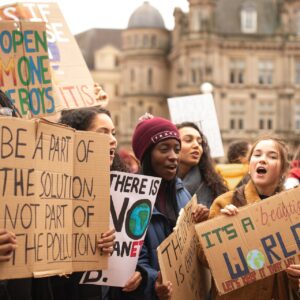What will success at NatureCOP look like?
With COP15 – or NatureCOP – starting today in Montreal we are poised at a potential turning point for nature. Delayed for two years due to COVID, the international community is finally coming together to see if they can work across differences to agree on a global plan to save nature under the UN Convention on Biological Diversity (CBD).
With close to one million species hurtling towards extinction around the world, including over 2,000 plants and animals at risk in Canada, action can’t come soon enough. Scientists are referring to this crisis of biodiversity loss as the sixth mass extinction effect in history, noting it is human-caused—and creating a tipping point for planetary stability.
The Canadian government has been taking notice and stepping up in a leadership role. At the G7 Summit in 2021, Canada and other nations put forward a bold new vision, committing to Halt and Reverse Nature Loss by 2030 as part of a “Nature Compact”.
A number of ”high ambition” countries like Canada are working hard to make ‘Halt and Reverse Nature Loss’ the overarching aim of the new CBD global framework; a clear global goal to act as a North Star in setting targets and strategies for the next ten years. Currently, things are looking uncertain. Even the word “halt” is in brackets in the draft negotiating text, which is UN code for ‘not agreed to yet’.
But Canadians and citizens around the world are mobilizing as never before. We’ve seen this through the NatureBus Tour with our supporters and newly engaged folks joining us at every step of the way inspiring us to keep up the pressure to protect nature.
The Nature Canada team is in Montreal to carry your messages and hopes for Nature, working with partner groups, community, and Indigenous leaders to push decision makers to show leadership at this pivotal moment.
What are we hoping for from NatureCOP?
There are five key things we are watching for:
1. Agreement on a strong new Global Biodiversity Framework with measurable targets to halt and reverse nature loss by 2030 across land and ocean over the next decade.
The world gathers only every ten years to set new targets under the CBD and the last set of targets, which expired in 2020, remain largely unmet. A new ten year post-2020 Global Framework should include:
- Comprehensive and Measurable targets: We need effective and measurable commitments—like a global goal to protect 30 percent of land, freshwater, and ocean by 2030—under 21 target areas that can truly address the core drivers of biodiversity loss, including habitat destruction and degradation from the changing use of land and ocean, direct exploitation of nature, climate change, pollution and invasive species. Clear targets will help us hold governments accountable.
- Equity and Adequate Resources: A new global deal must recognize the differential capacity of wealthy and poorer countries to address biodiversity loss, and the larger role the Global North has played in the overexploitation and destruction of nature to date. Significant commitments of financing from the North to the South are needed. Resources should also be mobilized by commitments to redirect subsidies that are causing harm to nature.
Nature – Climate linkage: The global deal must recognize that nature is a key ally in the fight against climate change and that nature’s resilience is also eroded by climate change and needs protection.
2. Clear support for Indigenous rights and leadership in the global agreement, during the COP proceedings, and through new Canadian commitments
As a country committed to reconciliation, and home to vibrant strong Indigenous communities, we will be looking to see how Canada supports the full and effective participation of First Nations, Inuit and Métis nations in all aspects of COP15 deliberations. In line with recent calls from the Assembly of First Nations, we also want to see Canada advocate for a global biodiversity deal that puts Indigenous rights and knowledge at its center, and calls on all conservation actions to uphold the rights of Indigenous peoples to self-determination and free, prior, and informed consent.
More specifically, Canada should use NatureCOP as an opportunity to increase funding and develop new financing tools. Canada needs to expand Indigenous Protected and Conserved Areas and Indigenous Guardians initiatives to match the level of ambition desired by First Nations, Inuit and Métis communities (more than 500,000 square kilometers of new protected areas).
3. Canadian leadership including through a public commitment for a comprehensive national action plan to halt and reverse biodiversity loss—at land and sea—by 2030
Beyond leadership in working to land a global deal, Canada must signal its commitment to deliver a high-ambition national action plan that will engage all levels of government, Indigenous governments, and wider stakeholders to halt and reverse nature loss in Canada by 2030. This action plan needs to be developed post COP15, but the government should commit that it will:
- Reflect a whole of government approach to align federal policies and actions with Canada’s biodiversity commitments
- Centre Indigenous rights and conservation
- Reinforce the commitment to protect 30 percent of lands and ocean in Canada by 2030
- Set a target for restoring degraded ecosystems and accelerate action for species recovery
- Expanded support for nature-based solutions to better value and conserve Canada’s biodiverse, carbon-rich ecosystems on land and sea
- Lay out a timeline to end forest, farming and agricultural subsidies that harm nature
- Strengthen accountability measures to support implementation, including creating stronger laws in Canada
- Include a strategy to engage the public on the urgency and opportunity to protect nature and expand equity of access.
4. The Ocean is in the Room. Clear priority must be given to safeguarding ocean biodiversity at NatureCOP
Oceans must be central to discussions at COP15. Most of the planet is ocean and we are still learning about the incredible biodiversity it contains. What we do know is that the health of the ocean is essential for our own. We will be watching to see if world leaders remember to #CarryTheOcean in the room during negotiations for a global deal for nature.
Canada can demonstrate ocean leadership at the COP with action at home to better protect intact ocean ecosystems. A great start would be committing to a limit to the northward expansion of bottom trawling and declaring a moratorium on seabed mining in Canadian waters. We’d also like to see new approaches and funding to better protect and restore fish habitat in freshwater and coastal ecosystems.
5. The Birth of a Nature movement
We hope Montreal can be a historic turnaround moment for nature, where collectively, we’ve sparked a movement for accountability to end this crisis. We know that Canadians care deeply for nature and can be rallied to support new policies and approaches to secure our shared future. Let’s hope Montreal can be for Nature what Paris was for Climate.
Already the NatureBus tour has sparked a massive coming together of diverse people of all ages, regions, backgrounds and walks of life. At NatureCOP in the weeks ahead, we hope to see people demanding change in creative ways from demonstrations in the streets, to art exhibits, to letter writing, to local and online events and beyond. On December 10th, there will be a March for Biodiversity and Human rights. Nature Canada will be there, inspired by your passion.
We will send you updates from COP and reflect back to you how we fared on these five critical issues when it’s over.
And together, all parts of society will need to carry this momentum forward long after the COP as well. It’s up to us to sustain the pressure on decision makers to deliver on global and Canadian commitments to restore and protect nature over the next critical decade.
Stay with us!



